Owls are renowned for their incredible hunting abilities and unique adaptations. One of the most intriguing aspects of an owl’s anatomy is its seemingly small beak, which raises the question: How does an owl swallow with such a tiny beak? This article delves into the fascinating mechanics behind an owl’s swallowing process.
Owls possess a specialized adaptation known as the “gular pouch,” located at the base of their throat.
This expandable pouch allows them to accommodate prey much larger than their beak size. When an owl captures its prey, it uses its sharp beak and talons to secure it.
As the owl begins to swallow, it elongates its neck and opening the gular pouch.
The prey is then compressed and manipulated by the owl’s tongue, which is covered in tiny, hair-like projections called papillae. These papillae help guide the prey down the owl’s throat. Read on for more details.
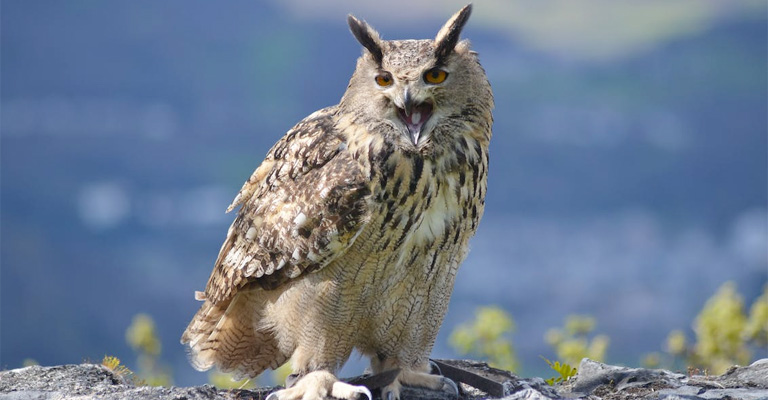
How Does an Owl Swallow with Such a Tiny Beak?
Let’s explore the process of how an owl swallows with its tiny beak and discover more details under each subheading for a comprehensive understanding.
Prey Capture
Owls have exceptional hunting skills, aided by their sharp talons and keen eyesight. When hunting, they rely on their ability to silently fly and pinpoint their prey in the dark.
Once they locate their target, they swoop down and capture it using their powerful talons. The prey is usually immobilized or killed instantly by the owl’s strong grip.
Beak Structure
While an owl’s beak may appear small compared to its body size, it is perfectly adapted to its specific dietary needs. The beak of an owl is sharp and curved, allowing it to tear apart prey efficiently.
It is also equipped with a specialized structure called the “rhamphotheca,” which is a layer of keratin that covers the beak’s surface, providing protection and strength. The sharp edges of the beak help the owl tear through the prey’s flesh and break it into manageable pieces.
Swallowing Mechanism
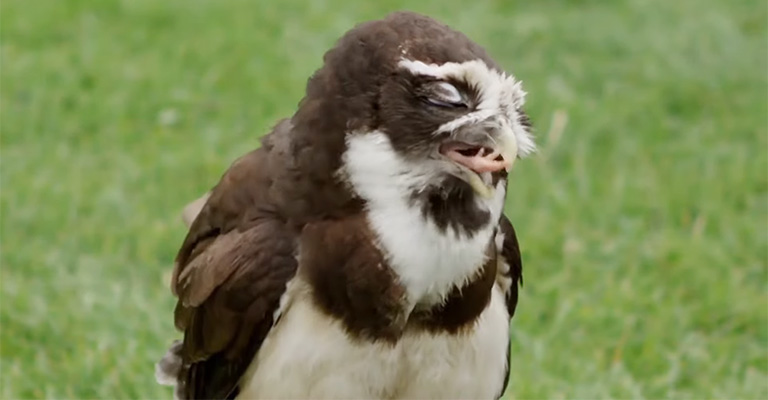
After capturing its prey, an owl begins the process of swallowing. Despite its small beak, owls have an incredibly flexible neck that allows them to rotate their heads up to 270 degrees.
This flexibility aids in the swallowing process by enabling the owl to position its prey for easier ingestion. The owl uses its beak to guide the prey towards its mouth, and with the help of its flexible neck, it can maneuver the prey into a suitable position for swallowing.
Regurgitation and Digestion
Owls are unable to chew their food like mammals do. Instead, they swallow their prey whole or in large chunks. Once the prey reaches the owl’s stomach, it undergoes partial digestion.
The digestive system of an owl is highly efficient, breaking down the prey’s soft tissues and extracting nutrients. The stomach acids and enzymes in the owl’s digestive system play a crucial role in breaking down the prey’s proteins, fats, and carbohydrates.
Pellet Formation
Unlike mammals, owls cannot digest certain parts of their prey, such as bones, fur, and feathers. These indigestible parts are formed into a compact mass called a “pellet” within the owl’s stomach.
The process of pellet formation involves the owl’s stomach muscles compressing and compacting the indigestible material, along with digestive juices and mucus, into a solid mass.
The pellet formation helps the owl remove the non-nutritive components from its digestive system.
Pellet Expulsion
The owl regurgitates the pellet by contracting its stomach muscles, pushing it up through its esophagus and out of its mouth. This process helps cleanse the owl’s digestive system and removes any indigestible material, making space for the next meal.
The expelled pellet is usually tightly packed and contains the remains of the prey’s bones, fur, feathers, and other indigestible parts.
Despite their small beaks, owls have evolved remarkable adaptations to facilitate the swallowing of their prey. Their sharp beaks, flexible necks, and efficient digestive systems allow them to capture, ingest, and process their food effectively.
How Do Owls Swallow?
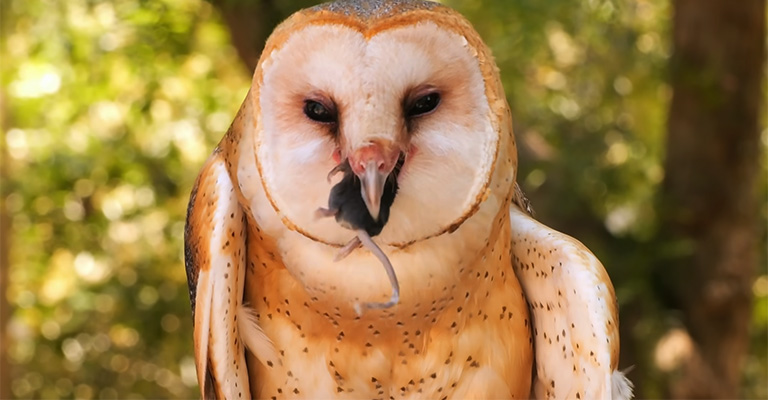
Owls have a fascinating way of swallowing their prey, despite their seemingly small beaks. Let’s explore the process of how owls swallow in more detail.
Capture and Securing Prey
Owls use their sharp beaks and powerful talons to capture and secure their prey. They typically target small mammals, birds, reptiles, and insects.
Gular Pouch
Owls have a specialized adaptation called a gular pouch located at the base of their throat. This expandable pouch allows owls to accommodate prey larger than their beak size.
Tilting the Head Back
Once the owl has captured its prey, it tilts its head back to begin the swallowing process. This elongates the owl’s neck and opens up the gular pouch.
Compression and Manipulation
The owl uses its tongue, which is covered in tiny, hair-like projections called papillae, to compress and manipulate the prey. The papillae help guide the prey down the owl’s throat.
Gravity and Neck Movements
Gravity plays a role in aiding the prey’s descent down the owl’s throat. Additionally, the owl’s flexible neck allows for precise movements to position the prey for swallowing.
Flexible Esophagus
Owls have a flexible esophagus that can expand to accommodate larger prey. This allows them to swallow prey whole or in large chunks.
Digestion
Once the prey reaches the owl’s stomach, it undergoes digestion. Owls have strong stomach acids and digestive enzymes that help break down bones, fur, feathers, and other indigestible parts.
Regurgitation
In cases where the prey is too large or indigestible, owls have the ability to regurgitate pellets. These pellets consist of undigested materials such as bones and fur, which are expelled from the owl’s mouth.
What Are Owl Pellets?
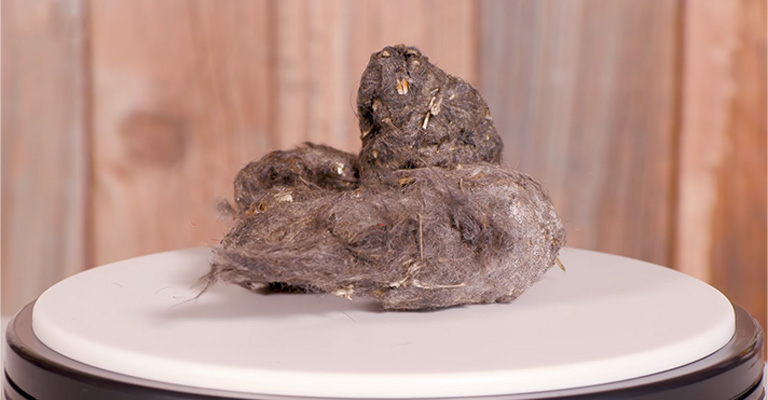
Owl pellets are compact masses of undigested materials that owls regurgitate. They are formed from the indigestible parts of the prey that the owl consumes, such as bones, fur, feathers, and insect exoskeletons. Let’s explore more about owl pellets in the following subheadings:
Formation of Owl Pellets
When an owl consumes its prey, the digestible parts are broken down and absorbed in its digestive system, while the indigestible parts are formed into a pellet in the owl’s gizzard. The gizzard is a muscular organ that helps grind and mix the food.
Once the pellet is formed, it moves up the owl’s digestive tract and is eventually regurgitated through the owl’s mouth.
Composition of Owl Pellets
Owl pellets consist of the undigested parts of the prey, including bones, fur, feathers, and insect exoskeletons. The specific composition of the pellets can vary depending on the owl’s diet and the types of prey it consumes.
The pellets may also contain other materials such as plant matter or small objects accidentally ingested by the owl.
Importance of Owl Pellets
Owl pellets can provide valuable insights into an owl’s diet and the ecosystem it inhabits. Scientists and researchers often study these pellets to identify the species of prey that owls consume and to study the food chain dynamics in a particular area.
Dissecting owl pellets can be an educational activity for students to learn about the diet and feeding habits of owls.
Owl pellets are formed from the indigestible parts of the prey that owls consume. They provide valuable information about an owl’s diet and play a role in ecological studies.
Features of Owl Beak
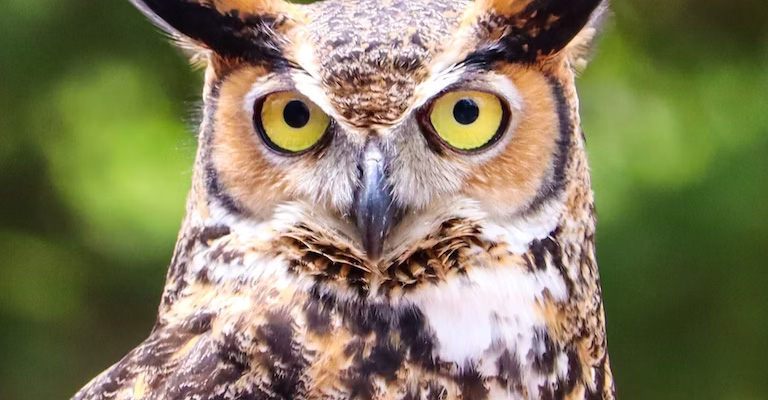
The beaks of owls are specialized adaptations that serve various functions essential for their survival as efficient predators. Here are some key features of owl beaks:
Sharp and Curved
Owl beaks are typically sharp and curved, resembling a hooked shape. This design allows them to grasp and hold onto prey effectively. The curved tip aids in tearing and manipulating the prey during the feeding process.
Talon Complement
The beak’s shape complements the sharp talons of owls. Together, the beak and talons work in tandem to catch, kill, and process prey. Owls use their talons to secure prey, while the beak helps tear it apart for consumption.
Nostril Position
Owl beaks often have a pair of nostrils positioned at the base. These nostrils are usually covered by specialized feathers called “facial discs.” These facial discs help direct sound towards the owl’s ears, aiding in their exceptional hearing.
Carnivorous Diet Adaptation
Owl beaks are well-suited for a carnivorous diet. They lack the hooked tip that many raptors like eagles and hawks have, which is used for tearing flesh from the bone.
Instead, owl beaks are adapted for grasping, crushing, and breaking down prey into smaller pieces.
Softness and Flexibility
Owl beaks are not as hard and rigid as those of some other birds. This softer structure allows for a certain degree of flexibility, which is important for accommodating larger prey items in the owl’s throat.
Feather Arrangement
The base of an owl’s beak is often surrounded by a facial disk made of specialized feathers. These feathers aid in channeling sound to the owl’s ears, helping them locate prey through their exceptional sense of hearing.
Variability Among Species
Different owl species might exhibit variations in beak shape and size, which reflect their specific feeding adaptations.
Some owls have shorter, stouter beaks suited for crushing small vertebrates like rodents, while others have longer, more pointed beaks for capturing insects or even fish.
Lack of Strong Bite Force
Owls generally lack a strong bite force compared to some other birds of prey. Instead, they rely on their beaks to manipulate prey and tear it apart into manageable pieces before swallowing.
FAQs
While owls have small beaks, their primary role in swallowing is to grip and tear apart the prey. Owls don’t chew their food; instead, they use their sharp beaks and talons to break down the prey into smaller pieces that can fit down their throats.
Yes, this swallowing adaptation is a common feature among most owl species. While the exact anatomy and size might vary slightly among different owl species, the basic mechanism of tearing and swallowing larger prey using their specialized throat structure is consistent.
Swallowing prey whole offers several advantages to owls. Firstly, it saves time and energy compared to chewing. Secondly, it helps in efficient digestion as the owl’s stomach acids can work on breaking down the prey’s nutrients.
While owls have evolved this effective swallowing mechanism, there are still limitations.
They can only swallow prey that can be torn into manageable pieces with their beaks and claws. Extremely large prey that can’t be broken down might pose difficulties for them.
Owls are skilled predators, but they do have their limits. While they can swallow prey that is quite large relative to their own size, there is a practical limit based on the owl’s own anatomy and the flexibility of its throat.
Bottom Line
The ability of owls to swallow prey larger than their beaks is a testament to the remarkable adaptations and efficiency of these nocturnal hunters.
The combination of a gular pouch, specialized tongue, and flexible esophagus allows owls to consume prey whole or in large chunks, ensuring their survival in the wild.
Studying the mechanics of an owl’s swallowing process not only deepens our appreciation for the wonders of nature but also provides insights into the intricate adaptations that enable different species to thrive in their environments.
The ability to swallow prey efficiently is just one of the many fascinating aspects of owl biology that continues to captivate researchers and nature enthusiasts alike.
Next time you encounter an owl, take a moment to marvel at its small beak and consider the incredible feat it accomplishes when swallowing its prey.